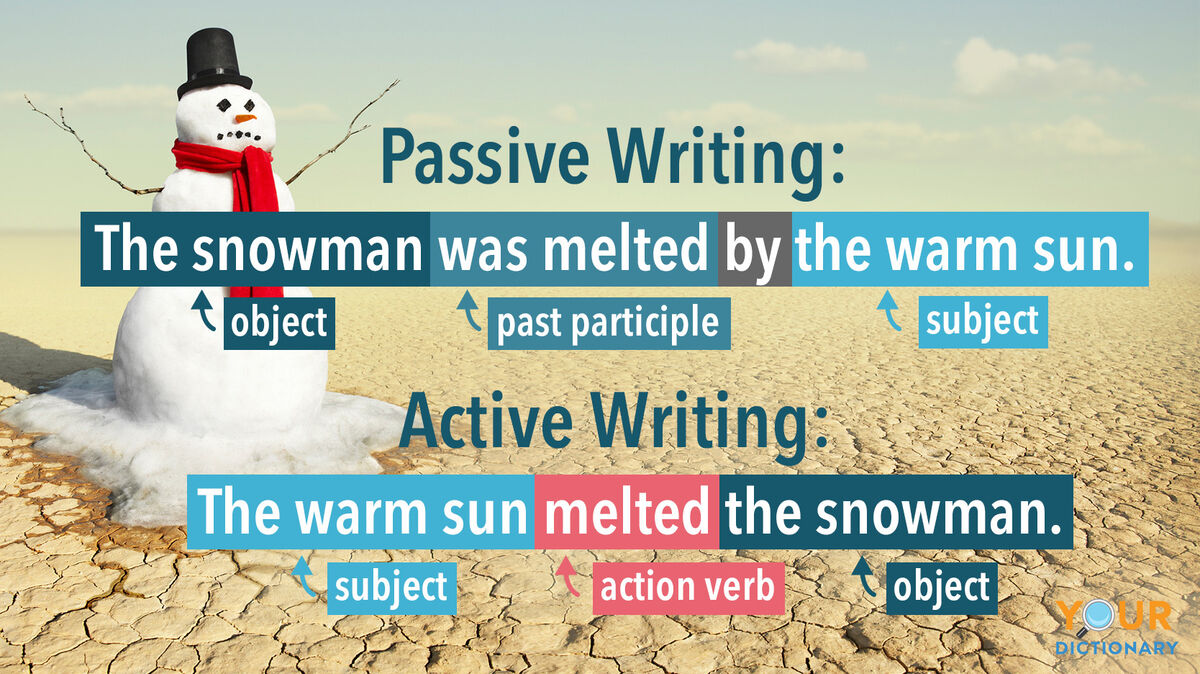
Writing in the active voice identifies both the action and who or what is performing the action. It adds clarity and precision to your words. But how can you be sure you're using the active voice in all of your sentences? Check out some easy tips to help you learn how to use the active voice in writing and how to fix passive voice when you find it.
Identify the Action and Subject in the Sentence
What's happening in the sentence? Finding a sentence's main verb is the first step to determining whether you're using active writing. For example, the main verbs are bolded in the following sentences:
- Passive - Our Christmas tree was decorated by the whole family. (Who decorated the tree?)
- Passive - The snowman was melted by the warm sun. (What melted the snowman?)
- Passive - That movie was seen by millions of people. (Who saw the movie?)
Who is actually performing these actions? The Christmas tree isn't decorating itself — the family is decorating it. Once you know what action is occurring in a sentence, you can determine who or what is performing that action — also known as the subject of a sentence. Then you can make sure that the subject goes where it should.
Put the Subject First
You'll often find that the object, not the subject, is the first noun in passive writing. One way to change a passive sentence to an active one is to flip the sentence around so it's clear who is performing the action. For example, in the following sentences, the bolded subject is last in the passive sentences but first in the active sentences. The italicized object also switches positions.
- Passive - Our Christmas tree was decorated by the whole family.
- Active - The whole family decorated our Christmas tree.
- Passive - The snowman was melted by the warm sun.
- Active - The warm sun melted the snowman.
- Passive - That movie was seen by millions of people.
- Active - Millions of people saw that movie.
Notice that when you use active writing, you reduce the number of words in the sentence. This includes passive linking verbs that don't need to be there.
Make Sure There Is a Subject
Because sentences in the passive voice often start with an object, it's easy to forget about the subject entirely. You often find this problem when a sentence includes modal verbs, such as "should," "can" or "will." For example:
- Passive - These mistakes will not be tolerated.
- Active - Management will not tolerate these mistakes.
- Passive - Your room must be cleaned before you go out.
- Active - You must clean your room before you go out.
- Passive - Bombs were dropped over the island last night.
- Active - The enemy dropped bombs over the island last night.
Leaving the subject out may be a purposeful use of passive voice, such as when the subject is unknown or doesn't matter to the action. But if your sentence doesn't fall into these instances, it's best to make sure you have a subject.
Avoid Passive Linking Verbs
Overly complicated sentences with additional helping verbs slow the reader down. You're most likely to find forms of "to be" (is, are, was, were) in passive voice. For example:
- Passive - Italian pizza is eaten by many people.
- Active - Many people eat Italian food.
- Passive - My cattle are being fed by Grandpa.
- Active - Grandpa is feeding my cattle.
- Passive - These mistakes should be avoided by us.
- Active - We should avoid these mistakes.
Adding these linking verbs makes the main verbs of the sentences into past participles, which is confusing when the sentence is actually in the present tense. When you remove the linking verb and put the subject in the right place, they are now in the active voice.
Be Careful With 'By' as an Adverb
Some words, such as "by," function as both prepositions and adverbs. For example:
- "By" as preposition - I bought the house by the lake. (describes where the house is)
- "By" as adverb - I bought the house by saving up my money. (describes how I bought it)
Both uses are grammatically correct. However, "by" as an adverb often shows up in passive sentences to improperly connect a subject with its verb. For example, in these passive sentences, the subject is italicized and "by" is bolded.
- Passive - The vault was broken into by a clever cat burglar.
- Active - A clever cat burglar broke into the vault.
- Passive - The road was being paved by the construction crew.
- Active - The construction crew was paving the road.
- Passive - The chocolate cake was baked by my aunt.
- Active - My aunt baked the chocolate cake.
Removing "by" from these sentences and reordering them makes them so much easier to understand. Once you get used to active writing, you'll find that active voice really adds impact to your writing.
An Active Approach to Writing
Active writing gets to the point and puts you right in the action. That's why we speak in active voice; it's the best way to communicate as clearly as possible. Take a look at these additional examples of sentences in the passive and active voice. If you're looking for a helpful visual, download an active vs. passive voice infographic for your classroom or writing notebook.